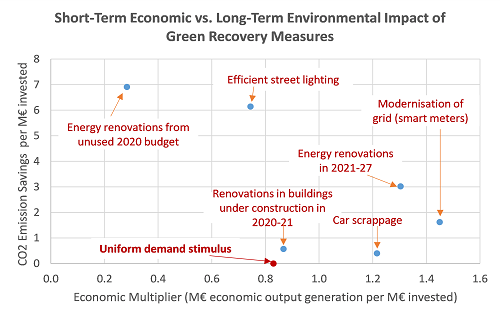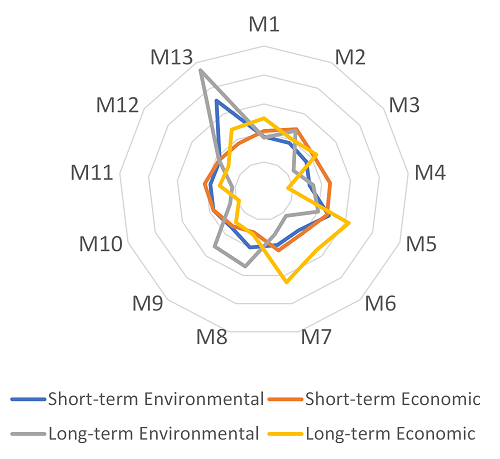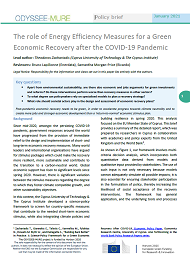Summary
Key questions
- Apart from environmental sustainability, are there also economic and jobs arguments for green investments and reforms? Do these interventions perform worse than recovery measures in other sectors?
- To what degree can policymakers rely on specialised models to plan a recovery strategy?
- What role should societal actors play in the design and assessment of economic recovery plans?
Post-pandemic economic recovery needs to be green, in order to accelerate progress towards climate neutrality and to create more jobs and stronger economic development than a ‘return-to-normal’ economic stimulus plan.
Lead authors: Theodoros Zachariadis (Cyprus University of Technology & The Cyprus Institute)
Reviewers: Bruno Lapillonne (Enerdata), Samantha Morgan-Price (Ricardo)
Background
Since mid-2020, amongst the persisting COVID-19 pandemic, government responses around the world have progressed from the provision of immediate relief to the design and implementation of short- and long-term economic recovery measures. Many world leaders and international organisations have argued for stimulus packages which could make the recovery more resilient, more sustainable and contribute to the transition to a carbon-neutral world. Global economic support has risen to significant levels since spring 2020. However, there is significant variation between the stimulus measures regarding the degree to which they foster climate compatible growth, and other sustainability objectives.
In this context, the Cyprus University of Technology & The Cyprus Institute developed a science-policy framework to screen for country-specific measures that contribute to the needed short-term economic stimulus, while also integrating climate policies and building resilience in spring 2020. This analysis focused on the EU Member State of Cyprus. This brief provides a summary of the detailed report, which was prepared by researchers in Cyprus in collaboration with academics and policy experts from the United Kingdom and the World Bank1.
As shown in Figure 1, our framework involves multi-criteria decision analysis, which incorporates both quantitative data derived from models and qualitative input provided by stakeholders. The use of such input is not only necessary because models cannot adequately simulate all possible impacts; it is also essential for ensuring stakeholder participation in the formulation of policy, thereby increasing the likelihood of social acceptance of the recovery interventions. The framework has general application, and the underlying tools and processes are selected in such a way as to allow their application to other national or regional contexts.
Figure 1: Approach to designing and assessing a green economic recovery strategy

After extensive deliberations with stakeholders from the public and private sector since the outbreak of the pandemic, we arrived at thirteen recovery measures to evaluate further. These are listed in Table 1. With the exception of measure M12, all interventions are directly or indirectly associated with energy efficiency improvements. A range of 23 sustainability criteria were used to assess these interventions for both the short- and long-term. The criteria were adapted from a comprehensive checklist developed by the World Bank for post-COVID19 economic stimulus interventions2. These criteria covered effects of a measure various aspects, including energy use, emissions, economic growth, jobs, energy security, social equity, and public acceptance. Furthermore, as the EU explicitly included the seventeen United Nations Sustainable Development Goals (SDGs) in its regular macroeconomic monitoring procedures in 2019, we linked each criterion with the SDGs that it addresses.
Quantitative evaluation was performed with an economic input-output model and the open-source energy systems model OSeMOSYS3. The qualitative part involved state-of-the-art multi-criteria decision methods engaging stakeholders from government, enterprises and civil society.
Table 1: List of the green recovery measures that were considered in this paper
|
Name of measure |
Investment in decade 2020-2030 (M€) |
|
M1. Immediate launch of grants for energy renovations of buildings from unused budget of 2020-21 |
30 |
|
M2. New grant scheme for energy renovations of existing buildings, 2021-27 |
140 |
|
M3. Grants for energy renovations of buildings under construction for upgrade to Near-Zero Energy Buildings |
70 |
|
M4. Installation of smart electricity meters |
55 |
|
M5. Virtual net billing for encouragement of photovoltaic installations by enterprises |
136 |
|
M6. Subsidy to loans of businesses certified with an environmental management system |
2 |
|
M7. Business4Climate scheme - grants to enterprises with a verified low-carbon action plan up to 2030 |
10 |
|
M8. Implementation of existing Sustainable Urban Mobility Plans (SUMP) |
100 |
|
M9. Construction of tram in the capital city of Nicosia |
225 |
|
M10. Scrappage scheme for old cars to be replaced with battery electric vehicles |
12 |
|
M11. Replacement of streetlights in municipalities and villages with energy efficient lighting |
45 |
|
M12. Tree planting along urban and intercity roads |
85 |
|
M13. Fiscally neutral carbon taxation for economic sectors out of the EU Emissions Trading System |
0.5 |
|
Total |
911 |
Results from energy and economic models
Figure 2 contains results from the model. It shows economic versus environmental effects of the modelled interventions. These results confirm the conclusion of analyses of previous recovery plans in western economies: measures performing best in the short run are often different from those with the largest positive effect in the longer term. With regard to economic growth, in the short-term, measures M4 and M5 (installation of smart electricity meters and virtual net billing) create the highest economy-wide effects – whereas other energy efficiency measures yield larger emission savings up to 2030. Impacts on employment are similar but not identical to those on economic output.
Some energy efficiency measures seem to have only a small effect on economic growth and jobs. For example, sustainable mobility interventions M8 and M9 do not perform well in terms of employment generation, thanks to their success to shift mobility from private cars to public transport. This causes household spending for fuel and car purchases to drop considerably, and the affected economic activities (imports of fuels and vehicles) are labour-intensive so that overall employment seems to be affected negatively.
However, such results should not be a reason to not implement energy efficiency investments. Input-output models contain assumptions for fixed technical coefficients. This implies that there is no substitution among inputs (capital, labour, energy) and no technological progress, which is plausible when considering short-term policy impacts but becomes less realistic when the impacts over a the long-term are modelled. In reality, the economic output and employment in sectors such as trade of vehicles and fuels could be compensated through re-training of workers and re-orientation of business activities in order to offset negative economic impacts of sustainable mobility. However, this is not reflected in the modelling. The ability of an economy to transform itself by using existing resources to grow new sectors, will depend on factors such as peoples’ skills, availability of financing and policy decisions. These aspects that are insufficiently accounted for by this kind of economic models.
It is particularly interesting to observe the results of a scenario that assumes a ‘return-to-normal’ economic stimulus, where all recovery funds are allocated uniformly to households and businesses, and consumption continues as before. Figure 2 shows that a business-as-usual recovery is not preferable; it performs better than only two out of all the green measures. It also has a poor effect in terms of employment generation, whereas four green measures have more than double job benefits.
Figure 2: Relationship between short-term impact of measures on economic output and long-term effect on carbon emission savings

Results from multi-criteria assessment
Models cannot simulate all impacts and the relative importance of each assessment criterion should not be determined by experts or public authorities alone. Therefore, a variety of stakeholders were invited to provide input for this assessment. They were selected in order to be representative of public authorities, businesses, and civil society, and participated in a dedicated workshop in October 2020, applying two state-of-the-art multi-criteria methods. Figure 3 displays results of this evaluation averaged over all stakeholders, before providing the final weighting of all criteria. The carbon tax reform (measure M13) received a high score for its environmental performance in both the short and the long term, and actions related to sustainable mobility (M8 and M9) also had a good score on long-term environmental performance. Conversely, measures M5, M6 and M7, which mainly target businesses, got the highest scores regarding long-term economic effectiveness.
Figure 2: Evaluation of recovery measures M1-M13 according to groups of criteria based on stakeholder input

We then derived the final ranking of the recovery measures based on model results and stakeholder input, using average scores and weights of all stakeholders. Some outcomes were expected – for example, grants for more energy efficient buildings, encouragement of photovoltaics, and investments in public transit. However, some results were more surprising. A measure that is often considered politically difficult – a budget neutral carbon tax – ranked first. On the other hand, modernising the energy infrastructure was not prioritised by stakeholders, because implementation delays would make short-term benefits uncertain. Even when they contradict expert opinions, these views need to be taken seriously, considering the direct experience of stakeholders and decision-makers: some measures may have lower social acceptance than experts believe, and may require more in-depth work to consider stakeholders’ concerns.
Conclusions
This policy brief has presented a multi-stakeholder framework to design an economic recovery strategy aligned with sustainability objectives, with a focus on energy efficiency measures. As noted above, this type of approach needs to be complemented by a broader look at recovery measures, including factors not directly related to energy and climate change. For instance, public investments will be directed to health and social care and information and communication technology, and green and climate considerations will need to be included in the design of these investments.
Although it is always possible to do more sophisticated analyses to refine policy prioritisation, timeliness is always critical in a crisis. Our two-step approach presented here, which combines modelling (when tools and data are available) and stakeholders’ views to prioritise actions, is one solution to find a compromise between timeliness and confidence about the appropriateness of specific policies. Because this approach is transparent and uses open-source methods, it can be applied in different countries and multiple policy contexts.
Notes
- 1: Zachariadis T., Giannakis E., Taliotis C., Karmellos M., Fylaktos N., Howells M. Blyth W., and Hallegatte S., “Building Back Better” in Practice: A Science-Policy Framework for a Green Economic Recovery After COVID-19. Economic Policy Paper, Economics Research Centre, University of Cyprus. Also forthcoming in the World Bank Policy Research Papers series.
- 2: Hammer S. and Hallegatte S., Planning for the economic recovery from COVID-19: A sustainability checklist for policymakers, World Bank blog on Development and a Changing Climate, 14 April 2020.
- 3: Taliotis C., Giannakis E., Karmellos M., Fylaktos N. and Zachariadis T. Estimating the economy-wide impacts of energy policies in Cyprus. Energy Strategy Reviews 29, 100495 (2020).
Similar to the approach described in this policy brief, the MURE database includes information and tools for assessing and ranking energy efficiency measures. For further reading on energy efficiency policies and indicators, please visit https://www.odyssee-mure.eu/






